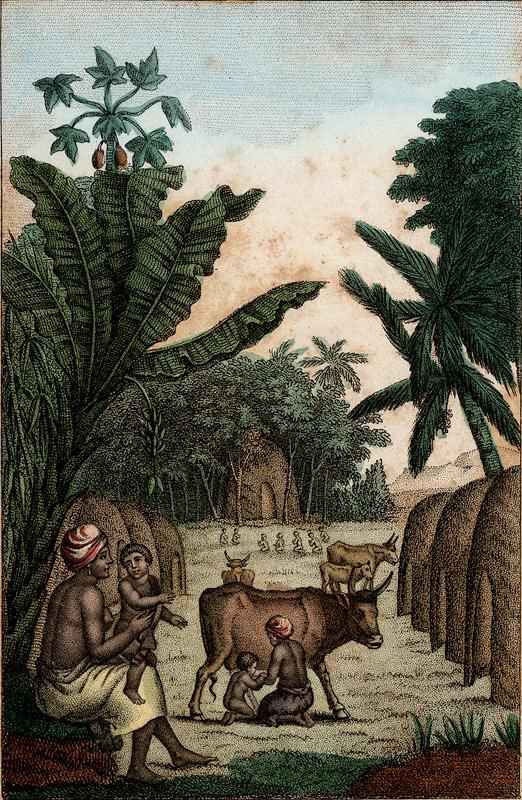
African Tribes: The Fula

Figure 1.-- The caption of this illustration read, "Cabanes et Temple des Phylans". It shows a woman and small child (foreground), another woman milking a cow (center foreground), with the conical thatched roof houses in a tropical setting. The drawing is an artists romanticized version of a Fula village in West Africa.
Source: Michel Etienne Descourtiz, Voyage d'un naturaliste (Paris, 1809), vol.1, facing title page.
|
|
The origins of the Fula are a matter of conjecture. There are atraditions of Semetic origins. Others speculate that the Fula arose from the mixing of proto-Berbers of North Africa and the Bafur Saharan people. Several other theories exist. We do know of any DNA studies. The Fula or Fulani (also Fulbe) today are an important ethnic group of about 25 million people spread 20 countries throughout Western Africa into Central Africa as well as the northern Sudan. The Fula are most prominnt in Cameroon, Guinea, Mali, Niger, Nigeria, and Senegal, but are found in mumbers throughout West Africa as well as nothwestern Cental Africa and the northen Sudan.
The bulk of the Fula people live from Lake Chad east to the Atlantic Ovean. While a major West African group, the Fula are a minority in all of the different countries they ingabit. They are most prominsnt in Guina (about 40 percent). The Fulani have traditionally been nomadic pastoralist and trading people which is why they are so widely distributed throughout West Africa. They have traditionally hearded cattle, goats and sheep across the extensive dry interior of West and Central Africa south of the Sahara. They thus pursued a life different and separate from the more settled agricultural populations because their lives and social organization was determined by the needs of the animals they hearded. Their language is Fula which is classified within the Atlantic branch of the Niger-Congo language family.
HBC

Navigate the Boys' Historical Clothing Web Site:
[Introduction]
[Activities]
[Biographies]
[Chronology]
[Cloth and textiles]
[Clothing styles]
[Countries]
[Topics]
[Bibliographies]
[Contributions]
[FAQs]
[Glossaries]
[Images]
[Links]
[Registration]
[Tools]
[Boys' Clothing Home]
Navigate the Boys' Historical Clothing national pages:
[Return to the Main African tribe page]
[Algeria]
[Australia]
[Belgium]
[England]
[France]
[Germany]
[Ireland]
[Italy]
[Japan]
[Korea]
[Madagascar]
[Mali]
[Mexico]
[New Zealand]
[Scotland]
[Uganda]
[United States]
Created: 8:00 PM 3/23/2010
Last updated: 8:00 PM 3/23/2010



